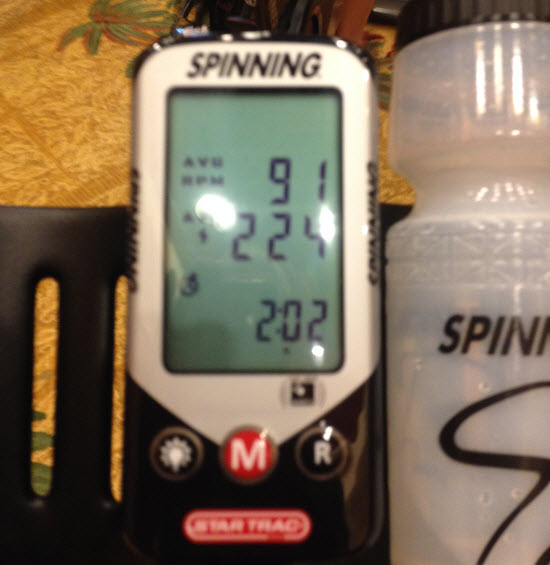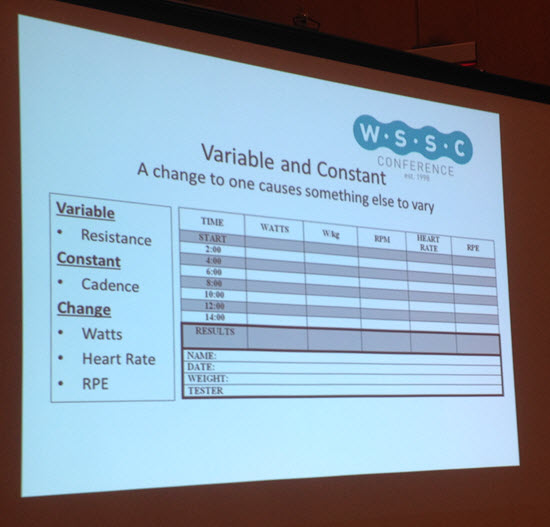 At WSSC I had the opportunity to complete a PST (Personal Spinning® Threshold) test - which is (their words) the key to Spinpower success. I couldn't agree more as knowing your maximum sustainable power or Heart Rate, and then building training zones around a known metric BPM/Watts is crucial to effective training. Here's some notes on this session and the discovery process MI Janet Toussaint lead us through to determine our Personal Spinning® Threshold.
At WSSC I had the opportunity to complete a PST (Personal Spinning® Threshold) test - which is (their words) the key to Spinpower success. I couldn't agree more as knowing your maximum sustainable power or Heart Rate, and then building training zones around a known metric BPM/Watts is crucial to effective training. Here's some notes on this session and the discovery process MI Janet Toussaint lead us through to determine our Personal Spinning® Threshold.
PST is something we can change
Janet's session included a lecture period before we climbed on the Blade Ions for the PST test. During her presentation she made three very profound points that I feel are important for anyone teaching with power, to convey to their participants...
- It is possible to change/raise/improve your PST. You maybe familiar with the statement; if you can test it you can improve it. In the past the Spinning program was based on Maximum Heart Rate - a number that doesn't change no matter how hard you train. Yes you can become more efficient at Fat utilization, except that's difficult to measure without a metabolic cart. Sustainable power at threshold (PST) is something you can easily see changing and that can be very motivating.
- PST is based on Maximal Efficient Effort - key word being efficient, as in where efficiency drops off during the graded intensity ramp test. This isn't a test where COME HELL OR HIGH WATER I'M GOING TO PUT UP THIS HUGE WATTAGE NUMBER!!! Janet made the point a number of times that you have to be careful not to let these assessments become a competition, where people are trying to prove something.
- Your PST is specific to this sport - actually Angie Sturtevant made similar statements. The wattage you see as a PST only applies to a Spinning class - not your road bike with a power meter. I would add that it also only applies to the specific brand of Indoor Cycle.

I snapped this picture showing the ramp test protocol used to asses the PST used to create the 6 power zones in the SpinPower program.
Constants and Variables
The constant during this test is cadence/RPM which doesn't change during the test. Janet suggests you not mandate a cadence, instead ask every one find "where they hang out" = natural cadence. What will vary will be the amount of resistance, and the resulting changes in HR and perceived exertion/RPE.
- Start everyone warming up in zone one, finding that natural cadence for 10 or more minutes. Include a few brief accelerations - but not too intense or long.
- Every two minutes you'll add resistance / ramp up. How much? Janet recommends 10-20 watts from women and 15-30 watts for men.
- After you've added the new ramp, push the reset button to record your average for that ramp - remembering the previous ramp's wattage.
- When you can't maintain your cadence, for the whole two minutes, you're done. Your PST is the watts from the last fully completed ramp.
- How many ramps is the right amount? Janet explained that there is no "right amount". You need to run the assessment until everyone has completed the test. There were some questions about this and it sounds like you should see at least 4 ramps until failure. Less than that probably means that the rider is adding too many watts with each ramp.
My experience during the test was as I got closer to PST, I wanted to reduce the size of each ramp's increase. I also knew very quickly when I wouldn't be able to finish a ramp. My numbers are in the image above. I couldn't complete my last ramp of 240 watts, which actually isn't that far off what I'm used to seeing as my threshold on the FreeMotion bikes I teach on at Life Time.
Thinking about conducting an assessment like this in your class? I would suggest that you practice on yourself first, so you understand what your riders will be experiencing.
If you are teaching on Spinner Blade Ions I would love to talk to you. Please contact me.
Originally posted 2014-06-11 11:44:17.
- ICI Podcast 196 Go Cycle Studio is using the Top Power Display from Performance IQ - December 26, 2025
- You're a Celebrity… act like it! - September 24, 2025
- Lessening the pain of HIIT or Tabata® cycle training - September 18, 2025

Awesome info! And great timing…..I have just started instructing at a club that has watts on the bikes. Thanks!